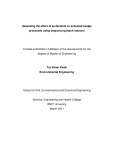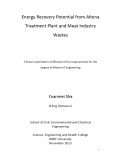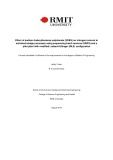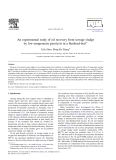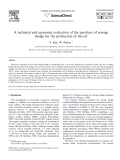
Activated sludge
-
This work demonstrated the potential of US for mitigating membrane fouling. However, the integration of the US transducers within the membrane system will be a major challenge for the application of US in membrane cleaning. It is more appropriate that US is used as pre-treatment to the membrane system, the transducers can be placed prior to the coagulant feed line. Further work on the determination of the detailed mechanisms associated with enhancing coagulation would enable optimisation of the system with regard to process, cost and energy efficiency.
 108p
108p  runthenight05
runthenight05
 01-03-2023
01-03-2023
 17
17
 3
3
 Download
Download
-
Anionic and non-ionic surfactants have been detected in the influents to and effluents from wastewater treatment plants (WWTPs). Linear alkylbenzene sulphonates (LAS) and alkylphenol ethoxylates (APEO) are the most frequently detected anionic and non-ionic surfactants in urban wastewater. The aim of this study was to assess the effect of the presence of anionic and non-ionic surfactants in the influent to WWTPs on activated sludge processes.
 111p
111p  runthenight05
runthenight05
 01-03-2023
01-03-2023
 9
9
 3
3
 Download
Download
-
The aim of this project is to provide a summary of the current knowledge on energy recovery options from wastewater treatment plants sludge and/or biosolids. This covers technologies as well as data from case studies and research experimental results. The focus of the study is the ATP. The project methodology comprised two stages. The first stage involved a review of the current literature.
 166p
166p  runthenight07
runthenight07
 01-03-2023
01-03-2023
 11
11
 3
3
 Download
Download
-
The primary objectives of this study were to: Investigate the fouling potential, and characterise the organic components of the membrane foulant layers, of clarified activated sludge and lagoon effluent obtained from the WTP; Investigate the fouling propensities of EOM and AOM derived from a blue-green algal culture as it passed through the growth cycle, ie., for which the cells had not been subject to physical disruption; Determine any difference in the fouling propensity of EOM and AOM and relate it to organic composition.
 99p
99p  runthenight07
runthenight07
 01-03-2023
01-03-2023
 3
3
 3
3
 Download
Download
-
Municipal wastewater treatment plants generally utilise biological activated sludge processes to remove organic compounds and nitrogen. The biological nitrogen removal (BNR) occurs in two steps, nitrification (ammonium removal) and denitrification (nitrates removal). This study focused on a medium-sized wastewater treatment plant (WTP) which experienced poor nitrification for years, mainly when the weather temperature drops.
 125p
125p  runthenight07
runthenight07
 01-03-2023
01-03-2023
 12
12
 3
3
 Download
Download
-
This research aimed to study the effect of salt (NaCl) concentration on the treatment efficiency of seafood processing wastewater by the use of a laboratory-scale bioreactor, which is operated in anaerobic combining aerobic system with concentration salt different from 0- 5%.
 10p
10p  tocectocec
tocectocec
 25-05-2020
25-05-2020
 14
14
 2
2
 Download
Download
-
Recovering useful hydrocarbons from sewage sludge using zirconia-supporting iron oxide catalysts was investigated. Zirconia has activity for decomposing water molecules to generate active oxygen and hydrogen species.
 6p
6p  tuananhhumg
tuananhhumg
 04-11-2013
04-11-2013
 37
37
 2
2
 Download
Download
-
Pyrolysis of activated sewage sludge was investigated under inert conditions in a fluidised-bed to study the effects of temperature and gas residence time on the product distribution and composition with an aim to maximise the oil yield.
 8p
8p  tuananhhumg
tuananhhumg
 04-11-2013
04-11-2013
 78
78
 5
5
 Download
Download
-
Pyrolysis to produce bio-oil from sewage sludge is a promising way, to not only improve the economical value, but also to reduce pollutants associated with sludge. The aim of this study was to evaluate the production of oil from primary, waste activated and digested sludges.
 8p
8p  tuananhhumg
tuananhhumg
 04-11-2013
04-11-2013
 59
59
 2
2
 Download
Download
-
Hệ thống xử lý nước thải của Bệnh viện đa khoa Đồng Tháp có công suất 250 m3/ngày với bể sinh học hiếu khí Aerotank được cải tạo thành bể sinh học tiếp xúc hiếu khí Activated Sludge combined with Biological Contactor- ASBC do không có khả năng xử lý nước thải đạt tiêu chuẩn, đặc biệt là các chỉ tiêu tổng Nitơ. Sau khi được cải tạo, HTXL với bể ASBC thể hiện hiệu quả xử lý cao hơn hẳn: 87,8% đối với COD, 71,2% đối với tổng N, 83,6% đối với tổng P, 99,98% đối với Coliforms. Nước thải đầu ra đạt tiêu...
 7p
7p  thoiaotrang290
thoiaotrang290
 10-05-2011
10-05-2011
 441
441
 150
150
 Download
Download
-
Biodegradation efficiency enhanced 10%~30% Short Hydraulic Residence Time (HRT) Long Sludge Residence Time (SRT) Activated sludge increase by 2~3 times No secondary settling and disinfecting tank required Automatic control operation is possible Better control of biological activity Quality Effluent that is free of bacteria and pathogens Smaller plant size Higher organic loading rates
 9p
9p  phuongltht
phuongltht
 06-04-2011
06-04-2011
 166
166
 25
25
 Download
Download
CHỦ ĐỀ BẠN MUỐN TÌM










